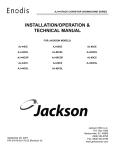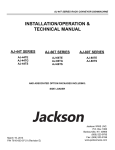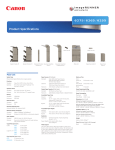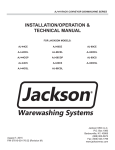Download JBL STUDIO™ SERIES Studio 120C
Transcript
JBL Studio 1 series ® loudspeakers User Guide Thank You For Choosing This JBL® Product For more than 60 years, JBL® engineers have been involved in every aspect of music and film recording and reproduction, from live performances to the recordings you play on the go and in your home, car or office. We’re confident that the JBL system you have chosen will provide every note of enjoyment you expect – and that when you think about purchasing additional audio equipment for your home, car or office, you will once again choose JBL products. Please take a moment to register your new product on our Web site, www.jbl.com. Registering enables us to keep you posted on our latest advancements and helps us to understand our customers and build products that meet their needs. Included Items Each box contains one or two loudspeakers, depending on the model, as indicated below. Studio 190 One Studio 190 speaker Studio 180 One Studio 180 speaker Studio 130 Two Studio 130 speakers Studio 120c One Studio 120c speaker Card with adhesive rubber feet (Studio 130 – two cards, Studio 120c – only one card) www.jbl.com 4 ENGLISH Placement Studio 190/Studio 180/Studio 130 – LEFT AND RIGHT CHANNELS For best results, place the speakers 6 – 10 feet (1.8m – 3m) apart. Angling the speakers toward the listening position can improve the stereo imaging. The speakers will produce the most accurate stereo soundstage when the angle between the listener and the speakers is between 40 and 60 degrees. 6 – 10 ft (1.8m – 3m) >20 in (>51cm) 40° – 60° Generally, bass output will increase as the speaker is moved closer to a wall or corner. For best performance, we recommend that you place the speakers at least 20 inches (51cm) away from the side walls. •• Position Studio 130 shelf speakers so that their tweeters are approximately at ear level. Peel the adhesive rubber feet from the card and apply them to the bottoms of the speakers. Rubber Feet 5 www.jbl.com Studio 120c You should place the center speaker directly above or below the center of your TV screen. The speaker’s center should be no more than 2 feet (61cm) above or below the tweeters of the front left and front right speakers. If your TV set is deep enough, you can set the center speaker on top of the TV, with the speaker’s front edge even with the TV’s front edge. Studio 120c Center Speaker 0 – 2ft (0 – 61cm) TV Studio 190/180/130 Front Left Speaker Studio 190/180/130 Front Right Speaker •• Peel the adhesive rubber feet from the card and apply them to the bottom of the speaker. Rubber Feet www.jbl.com 6 ENGLISH Studio 130 – Surround Channels (5.1-Channel System) When you use Studio 130 speakers as surround-channel speakers in a 5.1-channel system, place them slightly behind the listening position, facing each other. Ideally, they should be 5 – 6 feet (1.5m – 1.8m) above the floor. An alternate location would be on a wall behind the listening position, facing forward. The surround speakers should not call attention to themselves while they’re playing. Experiment with their placement until you hear a diffuse, ambient sound accompanying the sounds that you hear from the front left, front right and center speakers. Studio 190/180/130 Front Left Speaker TV Studio 190/180/130 Front Right Speaker Studio 120c Center Speaker Studio 130 Surround Left Side Speaker Studio 130 Surround Right Side Speaker Surround Right Speaker Surround Left Speaker 5 – 6 ft (1.5m – 1.8m) 7 www.jbl.com Studio 130 – Surround Channels (7.1-Channel System) When you use Studio 130 speakers as surround-channel speakers in a 7.1-channel system, place the surround side speakers directly to the sides of the listening position, at least 5 – 6 feet (1.5m – 1.8m) above the floor. Place the surround back speakers on the wall behind the listening position, also at least 5 – 6 feet (1.5m – 1.8m) above the floor and 3 – 6 feet (0.9m – 1.8m) apart. Studio 190/180/130 Front Left Speaker TV Studio 120c Center Speaker Studio 130 Surround Left Side Speaker Studio 130 Surround Right Side Speaker Studio 130 Surround Left Back Speaker www.jbl.com Studio 190/180/130 Front Right Speaker 3 – 6 ft apart (0.9m – 1.8m) 8 Studio 130 Surround Right Back Speaker ENGLISH Connections CAUTION: Make sure that all of the system’s electrical components are turned OFF (and preferably unplugged from their AC outlets) before making any connections. Speakers and amplifiers have corresponding positive and negative (“+” and “–”) connection terminals. All Studio 1 series speakers have connection terminals that are marked “+” and “–” on the terminal-cup assembly. Additionally, the “+” terminals have red markings, while the “–” terminals have black markings. To ensure proper polarity, connect each “+” terminal on the back of the amplifier or receiver to the respective “+” (red) terminal on each speaker. Connect the “–” terminals in a similar way. Do not reverse polarities (i.e., “+” to “–” or “–” to “+”) when making connections. Doing so will cause poor stereo imaging and diminished bass performance. IMPORTANT: Make sure the (+) and (–) wires or connectors do not touch each other or the other terminal. Touching wires can cause a short circuit that can damage your receiver or amplifier. Basic Single-Wire Connection Connect the amplifier to each speaker as shown in the illustration below. For the Studio 190 and Studio 180 speakers, you can use either set of terminals on the connector panel. IMPORTANT: Do not remove the metal jumpers from between the two sets of terminals when connecting the speaker wires. Studio 130, Studio 120c Speaker Connector Panel Receiver or Amplifier (One Channel Shown) ² Studio 190, Studio 180 Speaker Connector Panel Receiver or Amplifier (One Channel Shown) Use Either Set of Terminals Do Not Remove Jumper Strips ² 9 www.jbl.com The Studio 1 series speakers’ gold-plated speaker terminals can accept a variety of wire connector types: bare wire, pin connectors, spade connectors and banana connectors. Using Bare Wire or Pin Connectors: 1. 2. 3. Using Spade Connectors: 1. 2. 3. Using Banana Connectors: 1. www.jbl.com 2. 3. 10 4. ENGLISH Bi-Wire Connection (Studio 190/Studio 180) The Studio 190 and Studio 180 connection assemblies have two sets of input terminals that are connected by metal jumper bars. The upper set of terminals is for the midrange/tweeter, and the lower set of terminals is for the woofer(s). This arrangement allows you to bi-wire the speakers using a single stereo amplifier or using two stereo amplifiers. Bi-wiring can offer sonic advantages and more flexibility in power-amplifier selection over a conventional single-wire connection. Before bi-wiring the speakers, remove the jumper bars. Remove Jumpers Midrange/Tweeter Terminals Woofer Terminals Single-Amplifier Bi-Wiring Left Speaker Right Speaker Amplifier Left Ch. Midrange/Tweeter Connection Right Ch. Midrange/Tweeter Connection Woofer Connection Woofer Connection Dual-Amplifier Bi-Wiring Left Speaker Right Speaker Amplifier 1 Midrange/ Tweeter Connection Woofer Connection Left Ch. Right Ch. Left Ch. Right Ch. Amplifier 2 Midrange/ Tweeter Connection Woofer Connection For more information about various speaker-wire and connection options, contact your local JBL dealer. 11 www.jbl.com Caring for Your Speakers •• Wipe the cabinet with a clean, dry cloth to remove dust. Damp cloths may dull the cabinet’s finish. Do not use volatile liquids such as benzene, paint thinner or alcohol on the cabinet. •• Do not spray insecticide near the cabinet. •• To remove dust from the grille fabric, use a vacuum cleaner set to low suction. •• Do not wash the grilles in water, as it may fade the color or make it uneven. •• If the surfaces of the woofer and midrange cones become dusty, you can carefully sweep them clean with a soft, dry calligraphy brush or paint brush. Do not use a damp cloth. •• NEVER touch anything to the tweeter dome. www.jbl.com 12 ENGLISH Specifications Studio 190 Floorstanding Speaker Speaker type: Three-way dual-woofer, floorstanding Low-frequency transducer: Two 6-1/2" (165mm) PolyPlas™ cones, magnetically shielded Midrange transducer: 4" (100mm) PolyPlas cone, magnetically shielded High-frequency transducer: 1" CMMD® Lite dome, magnetically shielded, in a Bi-Radial® constant-directivity waveguide Power handling: 100 watts (continuous); 400 watts (peak) Frequency response: 40Hz – 22kHz Nominal impedance: 8 ohms Sensitivity (2.83V/1m): 90dB Crossover frequencies: 800Hz, 3.2kHz, 6dB/octave Enclosure type: Ported, with midrange subenclosure Connector type: Dual gold-plated binding posts (bi-wire capable) Dimensions (H x W x D): 44-1/8" x 7-7/8" x 14-3/4" (1121mm x 200mm x 375mm) Weight: 48.8 lb (22.1kg) Studio 180 Floorstanding Speaker Speaker type: Three-way floorstanding Low-frequency transducer: 6-1/2" (165mm) PolyPlas cone, magnetically shielded Midrange transducer: 4" (100mm) PolyPlas cone, magnetically shielded High-frequency transducer: 1" CMMD Lite dome, magnetically shielded, in a Bi-Radial constant-directivity waveguide Power handling: 90 watts (continuous); 360 watts (peak) Frequency response: 45Hz – 22kHz Nominal impedance: 8 ohms Sensitivity (2.83V/1m): 89dB Crossover frequencies: 1.1kHz, 2.5kHz, 6dB/octave Enclosure type: Ported, with midrange subenclosure Connector type: Dual gold-plated binding posts (bi-wire capable) Dimensions (H x W x D): 40" x 7-7/8" x 13-1/8" (1016mm x 200mm x 333mm) Weight: 38.6 lb (17.5kg) 13 www.jbl.com Studio 130 Bookshelf Speaker Speaker type: Two-way bookshelf Low-frequency transducer: 4" (100mm) PolyPlas cone, magnetically shielded High-frequency transducer: 1" CMMD Lite dome, magnetically shielded, in a Bi-Radial constant-directivity waveguide Power handling: 60 watts (continuous); 240 watts (peak) Frequency response: 60Hz – 22kHz Nominal impedance: 8 ohms Sensitivity (2.83V/1m): 87dB Crossover frequencies: 3kHz, 12dB/octave Enclosure type: Ported Connector type: Gold-plated binding posts Dimensions (H x W x D): 13-3/4" x 6-1/2" x 8-1/4" (349mm x 165mm x 210mm) Weight: 10.9 lb (4.9kg) Studio 120c Center-Channel Speaker www.jbl.com Speaker type: 2-1/2-way dual center-channel Low-frequency transducer: Two 4" (100mm) PolyPlas cones, magnetically shielded High-frequency transducer: 1" CMMD Lite dome, magnetically shielded, in a Bi-Radial constant-directivity waveguide Power handling: 60 watts (continuous); 240 watts (peak) Frequency response: 60Hz – 22kHz Nominal impedance: 8 ohms Sensitivity (2.83V/1m): 90dB Crossover frequencies: 900Hz, 12dB/octave; 1.8kHz, 24dB/octave Enclosure type: Ported Connector type: Gold-plated binding posts Dimensions (H x W x D): 6-1/2" x 21" x 9-7/8" (165mm x 533mm x 251mm) Weight: 18.6 lb (8.4kg) 14 ENGLISH Harman Consumer, Inc. 8500 Balboa Boulevard, Northridge, CA 91329 USA www.jbl.com © 2010 Harman International Industries, Incorporated. All rights reserved. Features, specifications and appearance are subject to change without notice. JBL, Bi-Radial and CMMD are trademarks of Harman International Industries, Incorporated, registered in the United States and/or other countries. PolyPlas is a trademark of Harman International Industries, Incorporated. Part No. 950-0308-001 15 www.jbl.com





















